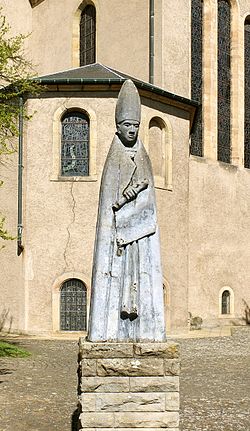St. Willibrord
| Willibrord | |
|---|---|

Statue of St Willibrord at Echternach.
|
|
| Bishop | |
| Born | c. 658 Northumbria |
| Died | 7 November 739 (aged 81) |
| Venerated in | Roman Catholic Church, Eastern Orthodox Church, Anglican Communion |
| Major shrine | Echternach |
| Feast | 7 November |
| Attributes | Dipping staff into cask |
| Patronage | Convulsions; epilepsy; epileptics; Luxembourg; Netherlands; Archdiocese of Utrecht, Netherlands |
Willibrord (Latin: Villibrordus;c. 658 – 7 November AD 739) was a Northumbrian missionary saint, known as the "Apostle to the Frisians" in the modern Netherlands. He became the first Bishop of Utrecht and died at Echternach, Luxembourg.
His father, named Wilgils or Hilgis, was styled by Alcuin as a Saxon of Northumbria. Newly converted to Christianity, Wilgils entrusted his son as an oblate to the Abbey of Ripon, and withdrew from the world, constructing a small oratory, near the mouth of the Humber, dedicated to Saint Andrew. The king and nobles of the district endowed him with estates until he was at last able to build a church, over which Alcuin afterwards ruled.
Willibrord grew up under the influence of St. Wilfrid, Bishop of York. Later he joined the Benedictines. He spent the years between the ages of 20 and 32 in the Abbey of Rathmelsigi, in Ireland, which was a centre of European learning in the 7th century.
During this time he studied under Saint Egbert, who sent him and eleven companions to Christianize the pagan North Germanic tribes of Frisia, at the request of Pepin of Herstal, Austrasian mayor of the palace, who had nominal suzerainty over that region. Willibrord travelled to Rome twice. Both of these trips to Rome have historical significance. As Bede tells us, Willibrord was not the only Anglo-Saxon to travel to Rome. The way in which he described the visit and its purpose is important; unlike all the others, Willibrord was not on the usual pilgrimage to the graves of the apostles Peter and Paul and the martyrs. Rather "he made haste to Rome, where Pope Sergius then presided over the apostolical see, that he might undertake the desired work of preaching the Gospel to the Gentiles, with his licence and blessing". As such he came to the pope not as a pilgrim but specifically as a missionary. The second time he went to Rome, on 21 November 695, in the Church of Santa Cecilia in Trastevere, Pope Sergius I gave him a pallium and consecrated him as bishop of the Frisians. He returned to Frisia to preach and establish churches, among them a monastery at Utrecht, where he built his cathedral. Willibrord is counted the first Bishop of Utrecht.
...
Wikipedia
